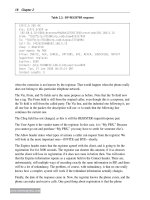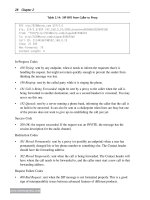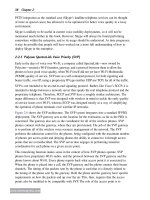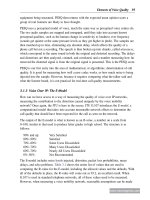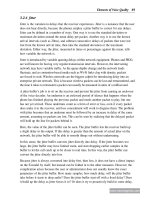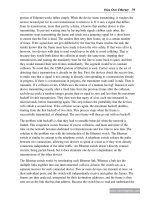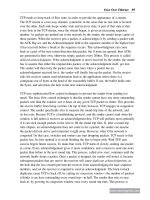Scalable voip mobility intedration and deployment- P38 pptx
Bạn đang xem bản rút gọn của tài liệu. Xem và tải ngay bản đầy đủ của tài liệu tại đây (142.96 KB, 10 trang )
Q
372 Index
codec engine, 8
codec impairment, 63–64
Code-Excited Linear Prediction
(CELP), 49–50
coder-decoder. See codec(s)
codes, in RADIUS, 326, 326t
collision detection, in Ethernet, 78–79
collision domain, 79–80
collisions
carrier sense avoiding, 145
in wireless transmissions, 113–114
collocated channel load balancing, 224,
225f
color(s)
measuring, 351
reducing the number of, 352–353
representation of, 352–353
color fidelity, sacrifice in, 353–354
communicator badges, 345
complementary code keying (CCK),
156
complex numbers, 150–151, 194–195
compression
artifacts, 358f
logarithmic voice, 47
lossy, 46–49, 352
motion, 358–360
perceptual, 49
quantization, 354
still image, 352–357
of video, 352–360
compressor, in video compression, 360
cones, in the eye, 351
conference calling
as a PBX feature, 10–11
talker echo in, 63
conference server, 14
confidentiality
by a secure network, 324
by a secure wireless network,
169–170
congestion, 98–99
congestion collapse, 146–148
congestion control, 87–88
congestion window, 89–90
congestion-marked packets, 99
CONNECT message, in Q.931, 41
connection
loss of, 239–240
user involved in, 108–109
WiMAX derived around concept
of, 303
connection ID (CID), 304
consecutive errors, 268–269
constellation
16-QAM, 159, 160f
64-QAM, 159, 160f
expanding in 802.11ag, 158–159
quadrature phase shift keying, 155,
156f
for a representation, 152–153
consumer-level gateways, 105
consumers, demands pushing Wi-Fi
industry, 104
Contact field, in the SIP REGISTER
message, 17
containment, 125
contention window (CW), 146
contention-based scheme, in GPRS,
299–300
Content-Length, in SIP, 17
Content-Type field, in a SIP invite, 21
continuous stream, for voice, 203–204
Contributing Sources (CSRCs), 51
control frames, 110, 112t, 114–115
controller, wireless, 121
controller-based access points, 121
controller-based architecture, 121
controller-based wireline, 121– 122
controllerless access points, 122
controllerless wireline, 122
controllers, mapping in 802.11r, 258,
260f
convergence, 2, 75, 307. See also FMC
(fixed-mobile convergence)
convolution operator, 196–197
convolutional encoder, in 802.11ag,
161
copper Ethernet technologies, 77–78
counter mode
AES encryption in, 341–342
AES running in, 52
in WPA2, 178
Counter Mode with Cipher Block
Chaining Message Authentication
Code (CCMP), 179
countermeasures
added in WPA, 178
eliminated in WPA2, 179
covariance, 200
coverage, 135, 281
coverage hole detection, 228
CPU, in a phone, 8
CRC-32 checksum
compared to Michael, 177
as cryptographically secure, 173
in an Ethernet header, 110
used in Ethernet, 77
in WEP, 172–173
cross-channel overlap, 273–274
cryptobinding, 191t
cryptographic mechanisms, 328–329
CSeq field, 17–18, 21
CSMA portion, of Ethernet, 78–79
CSMA/CA, 113–114, 145
CSMA/CD (Carrier Sense Multiple
Access with Collision Detection),
78–79
CSRCs (Contributing Sources), 51
CTS frames, 114–115
CTS-to-self protection, in 802.11g, 162
CW (contention window), 146
CWmax (maximum backoff CW),
206–207
CWmin (minimum backoff CW), 206
CWR flag, in TCP, 88, 88t
cycle of demand, 105
D
D channel, in ISDN, 40
data devices, forcing into 5GHz band,
284
data frames, 110, 112t
Data Offset field, in TCP, 88, 88t
data rates
in 802.11b, 149, 149t
described, 137–138
dropping, 146–148
throughput and, 138b
tradeoffs of, 137
trading robustness for speed,
137–138
data transmissions, observing, 239–240
dBm (decibels of milliwatts), 131
DCT (discrete cosine transform), 357
dead spots, in a network, 70
decibels, sound levels measured in, 47
decision to leave access point, 240–249
decompressor, for video, 360
dedicated circuit, 73
dedicated line, 73
default route, 83
delay, in voice mobility networks,
67–68
delay impairment, 62–63, 68, 68f
delayed acknowledgement, 89
Delivery Traffic Indication Messages
(DTIM), 211
delivery-enabled access categories,
212–213
denial-of-service vulnerability, in
TKIP, 178
density, effect on voice, 208
desensitization, supporting, 141–142
Destination, in IPv6, 86, 86t
destination address (DA), 113
destination Ethernet address, 77
Destination field, in IPv4, 82
destination MAC address, 110
Destination port, in TCP, 88
destination-then-source ordering, 110
DFS (dynamic frequency selection),
130, 284
DHCP server, 342–343, 346–347
diagnostics, types of, 287
dial-by-name directory PBX feature,
10–11
dialers, in enterprise-centric FMC, 313
dialing plan
described, 9
of the gateway, 294
in a PBX, 7
dialog token, 261, 263t
Q
Index 373
differentiated services, 91–94
Differentiated Services Code Point. See
DSCP
Diffie-Hellman keys, 340–341
digest scheme, 31
digital circuits, serial lines divided into,
40
digital PBXs, using IDSN lines, 41
digital sampler, in a phone, 8
digital sampling, for voice, 43
Digital Signature Algorithm (DSA),
331
Direct Sequence Spread Spectrum
(DSSS), 149
direct-extension dialing, 312
direct-link addresses, 83
directly connected architectures, 122
directly connected wireline, 122–123
disassociation message, 249–250
discarded frame count, 269, 270t
DISCONNECT message, in Q.931,
41
discrete cosine transform (DCT), 357
discrete Fourier transform, 355–357.
See also Fourier transform
distance weakening radio signals,
133f
distortion, 47, 62
distribution service (DS), 256–257
DL-MAPs, in WiMAX, 304
do-not-disturb PBX feature, 10–11
double-wide channels, in 802.11n,
168–169
downstream loss, 230
downstream part, support for, 245
downstream-only traffic stream, 216
drift, in frequency modulation, 149–
150
drop probability, 98–99
DS1, 40
DSA (Digital Signature Algorithm),
331
DSCP (Differentiated Services Code
Point), 204
backward-compatibility
requirement in, 205
defined, 92
tags, 204, 205t
for TOS precedence, 205
DSCP field, in IPv4, 93t
DSCP for Expedited Forwarding, in
UMA, 321
DSSS (Direct Sequence Spread
Spectrum), 149
DTIM (Delivery Traffic Indication
Messages), 211
dual-mode phone, 307
duplicate acknowledgements, 89–90
duplicate transmissions, 114
duration field, in 802.11, 111, 115
Duration Mandatory bit, 261–263
DVDs, compression algorithms with
key frames, 358–359
dynamic frequency selection (DFS),
130, 284
dynamic over-the-air architecture, see
microcell architectures
dynamic radio resource management,
124
dynamic routing protocols, 247–249
E
E-model
formula for network delay, 67–68
introducing the, 59–64
loss as a major factor in, 64–65
mapping R-value, 60, 61f
EAP (Extensible Authentication
Protocol). See also PEAP
(Protected EAP)
described, 328–330
framework, 180
making NAS into a proxy or
carrier, 329
providing a generic framework,
180
roles of supplicant and
authenticator, 329
EAP exchange, using MSCHAPv2,
189
EAP Failure message, 250–251
EAP message, 329–330, 329t
EAP methods, 182, 184
EAP over RADIUS, 329
EAP Request Identity message, 186,
186t, 250–251
EAP Request-TLS messages, 335
EAP Response-TLS messages, 335
EAP Success message, 183
from the authenticator, 191,
192t
from the RADIUS server, 250–
251
EAP TLV message, 190–191, 191t
EAP traffic, in EAPOL, 184
EAP types, 330
on certificates, 277–278
for TLS, 335
EAP-AKA, 337
EAP-GTC (Generic Token Card), 337
EAP-MD5 method, 184
EAP-SIM, 337
EAP-TLS, 182, 334–335
EAP-TTLS (tunneled TLS), 336
EAPOL (EAP over LAN), 329. See
also 802.1X
EAPOL Key message, 174–175
EAPOL Start message, 186, 186t
ECE (ECN-echo) bit, 99
echo, back to the talker, 62–63
echo cancellation, 62–63
echo tail length, 62–63
ECN (explicit congestion notification),
99
ECWmin, 206
edge effects, 229
EDGE technology, 300
802.11
concept of an “access point”, 127b
data rates in, 138b
frame format, 111, 111t
frames, 110, 112t
frequency occupation, 128f
implementing contention in, 146
scanning table contents, 234–235,
235t
security for, 169–192
security technology grades of, 179
802.11a, 157–162
802.11ag, 158, 159t
802.11b
data rates, 149, 149t
described, 148–157
protection of in 802.11g, 161–162
802.11F, 259
802.11g
data rates, 162
described, 157–162
protection of 802.11b, 161–162
802.11h, 261
802.11i, 173–176, 179
802.11k
capabilities of, 261, 262t
clients scanning procedure,
270–271
features of, 269–270
information about RF
environment, 276–277
neighbor report, 276
network assistance with, 259–271
overview, 270–271
transmitting stream metrics, 230
802.11n
data rates, 147f, 164
described, 162–169
802.11n Draft 2.0
features of, 163, 164t
products from, 163
802.11r
as a handoff optimization,
253–259
Authentication frame using,
116–117
as a form of key caching, 254
key hierarchy for, 254
use in channel layering, 276–277
preauthorization resource
allocation, 257–258
process for handoff, 255–256
transitions, 255–257
using key derivation, 255–256,
255t
in wireless architectures, 258–259
Q
374 Index
802.1X
authentication in, 181–183,
342–343
described, 183–184
supplicants and authentications,
252–253
time required for, 252
on wireline ports, 342–343
850MHz band, 299
eight-chip symbols, 156
11 Mbps data rate, 155–156
11-Chip Barker Code, 153–154, 154f
E-model
formula for network delay, 67–68
introducing the, 59–64
loss as a major factor in, 64–65
mapping R-value, 60, 61f
Enable bit, 261–263
Encapsulating Security Payload (ESP),
338
ESP header, 338, 338t
encoding concepts, for video, 350–352
encryption
application-specific, 341–342
in IPsec, 338
for smartphones, 346
in WEP, 171–172
encryption key. See key(s)
encryption operation, 331
end of service period (EOSP) bit, 213
endpoints
in Ethernet, 76–77
measuring voice quality, 72
end-to-end protection, 337–342
end-to-end security, 337, 342
end-to-end voice quality testers, 70–71
energy detection, 140–141
Enhanced Data Rates for GSM
Evolution technology, 300
enterprise mobile network, 2
enterprise PBX integration, 317
enterprise routers, forwarding rules, 83
enterprise security, in WPA or WPA2,
174
enterprise-centric FMC
architecture, 307
described, 307–314
draining enterprise resources, 313
features and benefits, 312– 314
in-building call with, 310f
out-of-building call with, 311f
PBX and telephone line resources,
313–314
using Wi-Fi intelligence and FMC
appliance, 319–320
enterprise-class devices, transition to,
364
ephemeral ports, in UDP, 87
equipment impairment factor, 63
ERP (Extended Rate PHY), 162
error concealment, 49
error correction codes, 158–161
ESP (Encapsulating Security Payload),
338
ESP header, 338, 338t
Ethernet
address format, 77t
cable, 106–107
described, 76–81
frame format, 76t, 110t
frames compared to Wi-Fi, 110
header fields, 110
hub, 78
MAC address, 109–110
prioritization for voice traffic, 204
protocols, 76
as a serial protocol, 77–78
switch, 79–80
Ethernet CRC, in IPv4, 82
EtherType field, 110–111
EV-DO (Evolution-Data Optimized)
technology, 302–303
excessive average errors, 268–269
exclusive or, 171–172, 300
Expedited Forwarding DSCP tags, 205
Expedited Forwarding (EF), 94
Expires header, 18, 21
explicit congestion notification (ECN),
99
exponent, in RSA, 331
exposed nodes, 143–145
extended channel, in 802.11n, 168
Extended Rate PHY (ERP), 162
Extensible Authentication Protocol. See
entries at EAP
extensions, dialing, 9
eye
cones in, 351
gamut seen by, 351
seeing only a few thousand colors,
352–353
F
failed frame count, 269, 270t
fair queueing, 96–97
far end echo, 62–63
“Fast BSS Transition”, 254
Fast BSS Transition IE, 255–256, 255t
Fast Ethernet, 80–81
“Fat” wireline, 120
FCC (Federal Communications
Commission), 102
FCS (frame check sequence), 77, 110
feedback loops, 247
femtocells, 321–322
FIFO (first-in first-out), 80
FIFO queueing, 95
FIN flag, in TCP, 88, 88t
find-me PBX feature, 10–11
firewalls, Skype finding ways around,
35–37
5.5 Mbps data rate, 155–156
5 GHz channels, 237–238, 284
fixed-mobile convergence. See FMC
flags
To and From DS, 113
in an Ethernet address, 77
in TCP, 88, 88t
flat fading, 197
floating-point numbers, 47–48
flow control techniques, in TCP, 89–90
Flow Label, in IPv6, 86
flow state, TCP tracking, 89
FMC (fixed-mobile convergence),
306–318
approaches to, 307
dialing software, 309, 312
gateway, 315
handoff problem, 318–320
industry unlocking, 106
mobility appliance, 308f, 309
mobility gateway, 315, 320
settling on the use of a dual-mode
phone, 307
soft clients, 343–344
follow-me PBX feature, 10–11
forgery protection
by a secure network, 324
by a secure wireless network,
169–170
4:2:2 compression, 354
four-digit dialing, 312
Fourier transform, 193–194, 355–357,
356f. See also discrete Fourier
transform
four-way handshake
composition of, 174–175
described, 174
letting two sides come together,
176
Message 1, 175
Message 2, 175
Message 3, 175–176
Message 4, 176
performing, 192
PTK and, 176
steps in, 251
Fragment field, in IPv4, 82
fragmentation, 84–85
frame(s)
differences between Ethernet and
Wi-Fi, 110
encoding, 76
in GSM radio, 299
in video, 352
in Wi-Fi transmissions, 109–110
in WiMAX, 304
frame aggregation, 167
frame body
in a beacon response, 265
with WEP, 173t
with WPA, 177t
with WPA2, 123, 179
Q
Index 375
frame check sequence (FCS), in
Ethernet, 77, 110
frame control field
in 802.11, 111, 111t
To DS and From DS flags, 113
frame encapsulation mechanism,
360–361
“Free Public WiFi”, 108–109
free space, 131
frequencies, converting an image to,
355
frequency modulation (FM), 149–150,
151f, 194
compared to phase modulation,
150, 152f
frisky client, 245–247, 248f
From DS flags, 113
From field, in SIP, 18
From line, in SIP, 17
FT Action frame, 256–257, 257t
full duplex operation, in Ethernet, 80
G
G bit, 77
G.279
RTP packets, 52
using mathematical rules, 49
G.279a, 49–50
G.711, 47, 63–64
G.711 codec, 65
G.711 compression, 49
G.729a, 66
gamut, 351
garbage-in-garbage-out problem, 136
gatekeeper, in H.323, 32–34
gateway(s)
in H.323, 32–33
misconfiguration or
incompatibility in SIP, 30
for signaling protocols, 11–12
SVP, 38
gateway switches, in a cellular network,
290f, 291
General Packet Radio Service (GPRS),
299–300
generations, of cellular technologies,
297
Gigabit Ethernet, over copper, 81
glitches, from handoffs, 67
global failure codes, in SIP, 30
global optimum, 247–249
GPRS (General Packet Radio Service),
299–300
group address, in IP multicast, 362–
363
group-addressed frames, 77
GSM (Global System for Mobile
Communications), 298–299
data services, 299–300
radio, 299
GTK (group temporal key), 175–176
H
H, in channel formulas, 200–202
H.225.0, 33
H.245, 34
H.323
architecture of, 32–34
described, 32–34
SIP compared to, 12
video conferencing applications
and, 32
hairpinning, 313–314, 314f
half-duplex network, 802.11 as, 138b
half-duplex transmissions, 78
hand in, 319–320
handhelds, new generation of, 364
handoff(s)
between access points, 125
causing consecutive packet losses,
66
between different networks,
318–320
glitches, 67
initiating too late, 242–244
issues with, 124
mechanics of channel layering,
275–276
to new access points, 109
planning for best possible, 282
proprietary methods for
improving, 241
between technologies, 67
tolerance of, 67
types of, 66–67
Wi-Fi making numerous, 319
handoff aspect, of Wi-Fi networks, 231
handoff behavior, general-purpose
settings for, 241–242
handoff control function, 272
handoff engine, 272–273
handoff environment, 231, 232f
handoff protocol, step by step, 249–250
handout, 319
handset. See also phone(s)
physically securing, 344–346
prevent theft of, 344–346
technology of, 5–7
handshaking protocol, TCP as, 89–90
hanging up, in SIP, 27
Hardware Size, in ARP, 84
Hardware Type, in ARP, 84
Header Checksum, in IPv4, 82
header fields, in 802.11 frames, 110
herd behavior, 246–247, 248f
hidden nodes, 142–143, 144f
hidden SSIDs, 237–238
high-definition (HD) video, 360
high-density networks, 280–288
higher-intensity samples, error
tolerating, 47
High-Speed Packet Access (HSPA),
302
histogram, 269, 270t
HMAC-SHA1,
in authentication protocols, 340
keyed signature, 52
hold music PBX feature, 10–11
home gateway, forwarding calls,
293–294
home location register (HLR), 292–
293
Hop Limit, in IPv6, 86, 86t
hop-by-hop security, 32
hop-by-hop switching, 74
horizontal handoffs, 319
HSPA (High-Speed Packet Access),
302
HTTP, SIP based on, 12
HTTPS
compared to SIPS, 32
web servers, 336
hub, Ethernet, 78
hunting PBX feature, 10–11
I
I (intra-coded) frame, 358
ICV (integrity check value)
in IPsec, 339
in WEP, 172–173
Identification field
in IPv4, 82
of a packet, 84–85
Identifier, in EAP, 329–330
IEEE 802.11 protocol, 109–118
IEEE 802.11 standard, 101
IEEE 802.16e, 303
IEEE Registration Authority, 76–77
IGMP (Internet Group Management
Protocol), 362–363
IKE (Internet Key Exchange) protocol,
340
images. See also pictures
converting to frequencies, 355
dividing into small rectangles, 357
IMEI (International Mobile Equipment
Identity), 298
impairments, for common codecs,
63–64
impulse response, of a channel,
196–197
IMSI (International Mobile Subscriber
Identity), 298
inactive phones, balancing, 220
Inactivity Interval, in a TSPEC,
216–218
in-band signaling method, 42
Industrial, Scientific, and Medical
(ISM) bands, 104, 135
information, 200
infrastructure architecture, 118–127
initialization vector (IV)
in IPsec, 339
in WEP, 171
Q
376 Index
in-progress codes, in SIP, 28
Institute of Electrical and Electronics
Engineers, 101
integrated devices, for Wi-Fi, 106
integrated services, 90–91
integrity
by a secure network, 324
by a secure wireless network,
169–170
in WEP, 172–173
integrity check value (ICV)
in IPsec, 339
in WEP, 172–173
intensity, 352–353
interaccess point handoffs, 230–277
Inter-Access Point Protocol (IAPP),
259
intercell interference, 135
interference
co-channel, 226
intercell, 135
measuring across antennas,
200–201
microwave, 124, 224
radar, 130
sources of, 130
transient, 229
in Wi-Fi networks, 134–135
intermediate frames, 358–359, 359f
international calls, dialing requirements,
9
International Mobile Equipment
Identity (IMEI), 298
International Mobile Subscriber
Identity (IMSI), 298
Internet
on circuit-switched technology
lines, 75–76
spread throughout the house,
105
Internet Engineering Task Force
(IETF), 12
Internet Group Management Protocol
(IGMP), 363
Internet Key Exchange (IKE) protocol,
340
Internet link, 317–318
Internet Low Bitrate Codec (iLBC),
50–51
Internet Protocol. See entries at IP
Internet Security Association and Key
Management Protocol. See
ISAKMP
interoperability issues, 28–29
inter-proxy forwarding, 28–29
intertechnology handoffs, 66–67
intratechnology handoffs, 66–67
intrusion, 323
inverse square law, 131
invitations, in SIP, 15, 19
INVITE request, 22, 22t
IP (Internet Protocol), 81–86
relaying or forwarding, 82–83
running on top of Ethernet, 83–84
IP addresses
binding to Ethernet addresses, 84
in IPv4, 81
mapping to Ethernet addresses,
83–84
phones using wrong, 28–29
IP multicast, 362–363
IP PBXs, 8–9
IP protocol 51, 339
IP-based voice network, 73–90
IPsec protocol
allowing for different protocols,
340
authentication header format, 339t
described, 338–341
key negotiation, 340–341
multiple sessions of, 338– 339
two types of encryption or
authentication, 338
UMA using, 320–321
IPv4
addresses, 85–86
described, 81–85
packet format, 82t
for voice mobility, 85
IPv6
addresses in, 85
described, 85–86
packet format, 86t
phone, 30
routing, 86
IS-95, 300–302
ISAKMP (Internet Security Association
and Key Management Protocol),
340
message exchanges, 340–341
UMA using, 320–321
ISDN protocol, 40
ISM bands, 104, 135
ITU
G.107, 59–64
G.113 Appendix I for common
codecs, 63–64
H.262 codec, 360
H.264 codec, 360
P.800, 58
IV (initialization vector)
in IPsec, 339
in WEP, 171
J
jitter
defining, 69
described, 69–70
introduced by variable queueing
delays, 69
requirements of Wi-Fi Alliance
tests, 279
jitter buffer, 69
causing to grow, 67
converting jitter into loss, 69
delay added by, 68
parameters, 69–70
underrun of the voice decoder, 69
jitter tolerance, 70
JPEG, 354
just-in-time handoff. See break-before-
make handoff
K
key(s)
generated in SRTP, 55
in WEP, 170–171
key caching
in 802.11r, 254
key exchanges
proprietary protocols, 259
as vendor-specific, 259
key frame, 358–359
key generator, in RSA, 331
key hierarchy, 174
for 802.11r, 254
in WPA2, 254
key negotiation, in IPsec, 340–341
L
L bit, 77
landline phones, 1
layered architectures, 124–125, 126f
legacy power saving mode, of WMM,
209–212
legacy support in 802.11n, 167
licensed wireless technologies,
spectrum rules, 104
licenses, for spectrum allocation, 102
linear cipher, 172
linear prediction, 50
link(s)
in Ethernet, 76–77
transmit side of Ethernet, 80
link measurement, 267
Link Measurement Request frame, 267,
267t
Link Measurement Response frame,
268, 268t
link-local addresses
in IPv4, 81–82
in IPv6, 85–86
range for, 81–82
listen interval, 210
listener echo, 63
load balancing
across bands, 223, 223f
across distances, 221, 222f
consequences, 221
described, 220–225
as main focus of client handoff
engine, 276
mechanics of, 221
Q
Index 377
as time-consuming, 224–225
within-band, 223
load factors, migrating connections
based on, 276
local process, client’s handoff behavior
as, 247–249
location tracking, of phones, 345
location-reporting capabilities, in
802.11k, 270
logarithmic compression, 47
longest-prefix matching, 82–83
loopback address, in IPv6, 85–86
loopback networking, address range
for, 81–82
loss. See also specific types of loss
rules of thumb for, 65
in voice mobility networks, 64–66
loss impairment, in the R-value, 63–64
lossy compression
algorithms, 46
codecs, 47–49
as method of deleting information,
47
for video, 352
lost bits, protecting against, 159–161
luminance, 353
M
MAC address filtering, 342–343
mailboxes. See ports, in UDP
make-before-break handoff, 273
management frames, 110, 112t
MAP (Mobile Application Part), 298
master key, 179, 182
Master Session Key (MSK), 329
Max-Forwards header, in SIP, 17
maximum backoff CW, 206–207
maximum contention window, 285
maximum established call capacity, 285
Maximum MSDU Size field, in a
TSPEC, 216–218
Maximum Policed Unit, in RSVP, 91
maximum ratio combining (MRC), 166
MCS (modulation and coding scheme),
163–164
Mean Data Rate, in a TSPEC, 216–218
Mean Opinion Score (MOS), 57–58, 65
measurement duration
in a beacon request, 264–265
in a beacon response, 265
measurement metrics, in voice quality,
57–64
measurement mode, in a beacon
request, 264–265
measurement pilot frames, 269–270
Measurement Report, 263, 264t
Measurement Report element, 261–263,
263t
measurement report mode, 263, 263t
measurement start time, in a beacon
response, 265
measurement token, 261–263, 263t
mechanisms and provisioning, 94–99
media gateways
described, 8–9
in IP PBXs, 7
in SIP, 15
media streams, synchronization of
multiple, 350
Medium Time field, in TSPEC, 218
megabits per second (Mbps), 137
memory, within the network, 252
messages, routing through the network,
75
MIC (message integrity code), 178–179
Michael MIC, 177–178
microcell architectures
compared to other architectures,
124–125, 126f
described, 123
reducing number of access points,
273–274,
networks, 226
microphone, in a phone, 5–8
microwave interference, 224
microwave ovens
emitting radio noise, 130
interference from, 124
triggering energy detection
thresholds, 140
milliwatts (mW), 131
MIMO (multiple-in, multiple-out), 162
described, 164–167
receiver, 166
requiring multiple antennas, 163
understanding, 198–200
minimum backoff CW, 206
minimum contention window, 285
Minimum Data Rate, in a TSPEC,
216–218
Minimum PHY Rate field, in a TSPEC,
216–218
Minimum Policed Unit, in RSVP, 91
minimum SNR, 136–137
mixed-mode devices, 106
MLP (Multicast Listener Discovery),
362–363
Mobile Application Part (MAP), 298
Mobile Country Code, in IMSI, 298
mobile devices, integrating Wi-Fi, 105
mobile IP
in controller-based architectures,
121–122
lack of interest in, 1
Mobile Network Code, in IMSI, 298
mobile operator, in cellular-centric
FMC, 315
mobile phones
with both cellular and Wi-Fi
radios, 307
with the cellular network and
Wi-Fi, 106
Mobile Switching Center (MSC), 298
mobile voice, 101
mobile workforce, cellphone usage by,
2
mobile-operator networks, 306
mobility
in cellular networks, 292–294
described, 1
within the geographic region, 292
as a main driver, 364
Mobility Domain ID, 255
Mobility Domain IE, 255–256, 255t
mobility domains, 254–255, 259
modem, data rate coming from, 137
modulation and coding scheme (MCS),
163–164
modulation function, 195–196
modulation schemes, in 802.11ag, 159
modulation technique, 149
modulations, 194–195
modulus, in RSA, 331
monopolistic coverage patterns,
282–284, 283f
More Data bit in the Frame Control
field, 211
MOS (Mean Opinion Score), 57–58, 65
motion compression, 358–360
MPEG-2 video, 360
MPEG-4 video, 360
MRC (maximum ratio combining),
166
MSC (Mobile Switching Center), 298
MSCHAPv2
challenge from the server, 190,
190t
challenge-and-response password
protocol, 336
inner taking place, 189
requesting identity of the client,
190
Success message, 190, 191t
MSK (Master Session Key), 329
µ-law, flavor of G.711, 47, 48t
multicast
crossing from one subnet to
another, 362–363
on Wi-Fi, 363
multicast address space, in IPv6, 85–86
multicast buffering, 211
Multicast Listener Discovery (MLP),
362–363
multicast networks, 362–363
multicast packet, 363
multicast routing, with IP, 362–363
multicast source, tree built back to,
362–363
multicast traffic, 81–82
multicellular networks, 135
multipath, effects of, 132–133, 136
multiple frame count, 269, 270t
multiple retry count, 269, 270t
Q
378 Index
multiple-in, multiple-out. See MIMO
multiple-radio standalone access points,
120
multiplexing, voice calls, 74
multivendor interoperability, of cellular
phones, 298
music. See hold music PBX feature
N
NAS (Network Access Server), 326,
328t
NAT (network address translation),
320–321
NAV (network allocation vector), 115,
143–144
near-end echo, 62–63
neighbor report(s)
under channel layering, 276
described, 266–267
handling by clients, 270–271
as not definitive for clients, 271
purpose of, 267
neighbor report element, 266–267, 267t
Neighbor Report Request Action frame,
266, 266t
Neighbor Report Response Action
frame, 266, 266t
network(s)
acting consistently for each client,
272–273
concepts from high-density,
280–288
deployed in the same spectrum,
229
fragmentation of, 274
handoff procedure, 275–276
handoffs between different,
318–320
physically protecting, 346–347
protecting end-to-end, 337–342
protecting from intrusion, 323
reasons for migrating connections,
276
transporting video over, 362–363
Network Access Server (NAS), 326
network address translation (NAT),
320–321
network administrators
ascertaining quality of voice
networks, 70–72
controlling encryption algorithm,
182–183
monitoring voice, 287
network allocation vector (NAV), 115,
143–144
network assistance
with 802.11k, 259–271
compared to network control,
231–234
in context of channel layering,
276
giving client more information,
233–234
improving operation of networks,
271
of phone handoffs, 231–232
“network busy” tone, 214
network congestion, 94
network control
with channel layering and
virtualization, 272–277
of phone handoffs, 231–234
network delay, 67–68
network load, impact on voice quality,
71
network resources, exhausting, 346–
347
network thickness, 229
network TPC, 226
network variation, avoiding, 281
network-focused solution, 272– 273
Next Header field
in IPsec, 339
in IPv6, 86, 86t
next hop, 82–83
900MHz band, 299
900MHZ cordless telephones, 104
1900MHz band, 299
nodes
exposed, 143–145
hidden, 142–143, 144f
noise, in Wi-Fi networks, 134– 135
noise floor, 61–62, 134
noise immunity (supporting
desensitization), 141–142
noise impairment, 61–62
noise levels
802.11k provision for reporting
on, 269–270
E-model, 59–60
noise values, in signal-to-noise ratio,
61–62
Nominal MSDU Size field, 216–218
nonces, 31, 175–176
nonlinear ciphers, 178
non-Wi-Fi devices, noise from, 135
null codec, 46
Null data frame, 211
number generator, pseudorandom,
171–172
Nyquist Sampling Theorem, 43– 44
O
OFDM (orthogonal frequency division
multiplexing), 158
OK message, in SIP, 23, 24t
OKC (opportunistic key caching)
described, 253
flaws of, 253
leveraging, 276–277
reducing security handoff
overhead, 252–253
“One times Radio Transmission
Technology” (1xRTT), 302
100BASE-TX, 80–81
1080 high-definition video, 350–351
1 Mbps, in 802.11, 152–155
1xRTT (One time Radio Transmission
Technology), 302
1700MHz band, 302
1900MHz band, 299
one-way audio, 245
opcodes, in an ARP message, 84
open authentication, 185, 185t
opportunistic key caching. See OKC
optimal mapping, 50
optimizations, in 802.11r, 254
Organizationally Unique Identifier
(OUI), 76–77
orthogonal frequency division
multiplexing (OFDM), 158
OS column, values in, 204–205
oscillations, representing, 193– 194
OUI (Organizationally Unique
Identifier), 76–77
out-of-band signaling, 7
outsider rejection
by a secure network, 324
by a secure wireless network,
169–170
overhead, in 802.11, 138b
overlapping channels, 130
overloaded access points, 221
over-the-air behavior, of wireless
networks, 119
over-the-air categorizations
dynamic, 123–124
layered, 124–125
static microcell, 123
virtualized, 125–127
over-the-DS transitions, 255–257
P
P (predictive) frame, 358
packet(s)
arrival of, 85
arriving for a UDP port, 86–87
classifying on a per-packet basis,
92
dividing into smaller ones, 84–85
as the fundamental concept, 74
on overhead mobility networks, 51
packet capture tools, 71–72
packet classification capabilities, 94
packet error loss, 66, 66f
packet error rates, 281
packet format, in IPv4, 82t
packet loss(es)
codec recovering from, 49
for handoffs, 66
packet loss concealment (PLC), 49
packet loss robustness, 63–64
packet networks, 90
Q
Index 379
packet number. See entries at PN
packet switching, 75
packet-based network, 42
packetized video, 349–363
packet-switched lines, 75–76
packet-switched networks, 74
paging, in legacy power saving, 209
paging mechanism, 209
pairwise master key. See PMK
parallel network, 288
parent TSF field, 265
parity check code, 159–161
passive report, 264
passive scanning, 237–238
password authentication, 336
passwords
cryptographically hashed out
versions, 181
for users, 181
path loss exponent (PLE), 132–133
PATH messages, in RSVP, 90
payload, in IPsec, 339
Payload Length, in IPv6, 86, 86t
PBXs
analog systems, 7
features, 10–11, 312
for IP-based telephone networks, 7
support of IPsec, 342
PCM (pulse code modulation), 46
with µ-law, 53–54
µ-law or A-law encoding, 49
Peak Data Rate, in a TSPEC, 216–218
PEAP (Protected EAP), 336
encrypted MSCHAPv2 response,
190t
encrypted request identity, 189t
encrypted response identity, 190t
presentation of username and
password, 187
triggering the start of, 187, 187t
PEAPv1, 337
peer address, 268–269, 268t
perceptual compression, 49
Perceptual Evaluation of Speech
Quality (PESQ), 58–59
perceptual model of voice, 59
per-connection key, 174, 179
per-frame key, 177
Personal security, 174
per-stream SNR, 202
PESQ (Perceptual Evaluation of Speech
Quality), 58–59
phase modulation (PM), 150, 152f,
194
phase offsets, calculating, 197
phone(s). See also cellular phones;
softphones
analog, 7–8
balancing inactive, 220
components of, 8
dual-mode, 307
landline compared to cellphones, 1
mobile, 106, 307
as multitasker, 231
registering in SIP, 13
roaming, 294
roaming into the enterprise, 315
shapes and sizes of, 8
using for a site survey, 286
phone calls
outgoing requests in SIP for, 20,
20t
ranking the quality of, 57
phone numbers, as abstract entities in
SS7, 42
phone software, in enterprise-centric
FMC, 313
physical carrier sense, 145
physical environment, changes to,
244–245
physical layer
802.11 transmissions at, 137
Wi-Fi firewalling solutions, 347
physical radio, 272
physical security, for networks,
346–347
picocells, adding into buildings, 321
pictures, 350–351. See also images
pilot subcarriers, 161
pilots, 141
pipe
protecting, 342–344
in voice mobility networks,
342
pitch, of a voice, 43
pixels, 350–351
PK (phase shift keying), 151–152
plaintext, in RC4, 171–172
PLC (packet loss concealment), 49
PLCP header, 139
PLE (path loss exponent), 132–133
plosives, 49
PMK (pairwise master key), 174
agreeing on, 251
for different access points, 252
disagreement of, 175
getting moved around, 259
inside the authenticator, 253
keeping secret, 176
passing to the network, 183
PMKID, 184, 253
PMK-R0, 254, 260f
PMK-R1, 254, 256t
PN (packet number), in WPA2, 179
PN sequence, in CDMA, 300–301
PoE (power over Ethernet), 106–107
point codes, in SS7, 42
point-to-multipoint, in GPRS, 299–300
polar coordinates, 150–151
polar graph, 194
policing, 98
polling protocol, 213
Polycom, SpectraLink Voice Priority
(SVP), 38–40
portability, in cellular architecture, 292
ports, in UDP, 86–87
POS Poll frame, 211
positive feedback loops, 247
power, 131
power constraint, for clients, 285
power control. See also TPC
aggressiveness, 285
in the client, 225–226
described, 225–226
within the network, 226
power instability, 281–282
power level
client backing off on, 225–226
reporting, 267–268
setting higher, 281
power management, 210–211
power meter, 140
power over Ethernet (PoE), 106–107
Power Save Poll frame, 211
power saving, 208–213
preambles
of 802.11ag, 161
of 802.11n, 167
described, 139–140
in Ethernet, 78
sent at lowest rate, 139
short and long in 802.11b, 157
preauthentication resource allocation,
257–258
pre-authentication resource
reservations, 255
precedence value, in IPv4, 92–93, 92t
prefix routing, 83
premaster secret, in TLS, 334
pre-shared keys. See PSK
primary channel, 168
primary RGB colors, 352
“priorities,” mapping, 204–205
prioritization
applying to TCP traffic, 362
getting over-the-air, 206
private addresses
in IPv4, 81–82
in IPv6, 85–86
private branch exchanges. See PBXs
private key, 181–182, 330
private telephone networks, 7
proactive call quality measurement
tools, 288
proactive diagnostics, 287–288
proactive testing, of voice networks, 71
probe delay.limiting active scanning,
238
Probe Request
active scanning with, 237–238
sending frame, 116
sending out, 237
Probe Responses, 237–238
Q
380 Index
probing, 237
proprietary extensions, used by voice
client, 228
Protected EAP. See PEAP
protocol(s), taking up bandwidth, 94
protocol analyzers, 287–288
protocol discriminator, 41
Protocol field, in IPv4, 82
Protocol Size, in an ARP message, 84
Protocol Type, in an ARP message,
84
protocol-based security, 341
proxy
sending caller a busy message in
SIP, 27
in SIP, 13, 15, 21, 24–25
pseudonoise code (PN code), 273
PSH flag, 88, 88t
PSK (pre-shared keys), 174, 181
keeping private, 179–180
as master, 251
sharing, 176
in WEP, 171
PSNonPoll mechanism, 211
PSPoll mechanism, 211
PTK (pairwise temporal key), 174
constructing, 175
derived from nonces, 175
deriving, 179
generating, 251, 253
getting moved around, 259
R1 key holder creating, 254
public key, 181–182, 330
public key cryptography, 330–331
public network
dialing out to, 9
not participating in handoff
process, 296–297
public switched telephone network
(PSTN), 290f, 291
protocol for, 42
routing calls to, 7
pulse code modulation (PCM), 46
with µ-law, 53–54
µ-law or A-law encoding, 49
puncturing, 161
Q
Q.931, 33, 40
Basic Format, 41, 41t
message types and meanings, 41
structure for messages, 40–41
QoS control field, 111, 111t
QPSK, 156, 159
quad-band phones, 299
quadrature phase shift keying, 155,
156f
quality of service
mechanisms, 90, 94–99
protocols, 37
providing in networks, 94
strictly enforced by WiMAX,
304
on wired networks, 90–99
quantization compression, 354
quantization process, in digital
sampling, 44–46
queueing delays, jitter introduced by,
69
queueing disciplines, 94
queues
in Ethernet, 80
for UDP ports, 86–87
R
R-value
components of, 60–61
computing for the E-model,
59–60, 60t
delay impairment, 68f
described, 59
impairment over packet loss rates,
66f
mapping directly to the MOS
value, 60, 61f
radar, interference from, 130
radiation patterns, of phones, 244–245
radio(s)
basics, 130–135
introduction to, 127
in a phone, 8
picking the same value, 146
sensitivity of, 141
types in Wi-Fi, 148–169
radio chains, required for antennas,
164–165
Radio Measurement Action frame, 261,
263t
radio network, 2
radio noise. See entries at noise
radio resource management. See RRM
radio resources, 124
radio signals, 102, 132
radio waves
passing through all materials
equally, 131
reflecting, 132–133
speed of, 132–133
transmitted signal as, 196
RADIUS (Remote Authentication
Dial-In User Service)
attribute format, 326, 327t
authentication components over
Wi-Fi, 181f
basics of, 325–328
codes, 326, 326t
described, 325
design of, 180
origins of, 325
services with, 325–337
transactions, 121
RADIUS Accept message, 191
RADIUS authentication, 250–251
RADIUS message, 326, 326t
RADIUS server, 325
random early detection (RED), 98–99
random packet-loss probability, 64–65
randomization interval, in a beacon
request, 264–265
RAS protocol, in H.225.0, 33
rate adaptation, 146–148
raw video, 352
raw voice stream, 352
RC4
as a stream cipher, 171–172
used by WEP, 116–117, 170
RCPI, in a beacon response, 265
reactive diagnostics, 287
Real-time Transport Protocol. See RTP
real-time video transport, 360–361
Reassociation Request message,
249–250, 255–256, 256t
Reassociation Response message,
249–250, 255–256
receive beamforming, 166
receive radio, of mobile device,
208–209
receiver address (RA), 113
receivers
for amplitude modulation, 149
hearing transmitters equally, 142
receiver’s noise, in the R-value, 61–62
record protocol, in TLS, 334, 335t
recording mechanisms, voice, 43f
rectangles, adaptive sizing of, 357,
358f
RED (random early detection), 98–99
redirection codes, in SIP, 28
redundancy
in SIP, 18
in wireless, 159
reflections
causing ripple patterns, 133
of radio waves, 132–133
of signals, 196
REGISTER request, in SIP, 16t
REGISTER response, in SIP, 17–18,
18t
registrars
signaling protocols for, 11– 12
in SIP, 13
Registration, Admission, and Status
(RAS) protocol, 33
registration, in H.323, 34
regulatory class, in a beacon request,
264–265
regulatory hurdles, 104
rejected calls, in SIP, 26–27
relative weight, each WFQ queue,
96
RELEASE COMPLETE message, 41
RELEASE message, 41
remote access point, 343–344
Q
Index 381
Remote Authentication Dial-In User
Service. See RADIUS
remote users, 343–344
repair parameters, 228
repeater, access point as, 118
replay protection
by IPsec, 339–340
missing in WEP, 177
providing, 177
by a secure network, 324
by a secure wireless network,
169–170
replays
allowed in RC4, 172
WEP not protecting against, 170
Report bit, 261–263
reported frame information, 265
reports, in 802.11k, 259, 261–263
request(s)
within 802.11k, 261–263
to register, 16
request and response model, of SIP,
12
Request bit, 261–263
request failure codes, in SIP, 28–29
Request Identity message, 186, 186t
request to send/clear to send. See RTS/
CTS protocol
requester, in SIP, 12
Request-Identity message, 330
Research in Motion Blackberry, 317
residue, 50
resolutions, 350–351
resource reservations, 90
responder, in SIP, 12
response codes, in SIP, 27–30
Response-Identity message, 330
RESV response, 90
retransmissions
sender 802.11s, 114
tracking, 114
RF activity, masking presence of
network, 347
RF calculations, 135–136
RF coordination, between access
points, 125
RF modifications, for voice mobility,
280–286
RF parameters, for access points, 123
RF planning
described, 123, 135–137
not predicting effects of multipath,
136
RF prediction tools, 135–136
RF primer, 117
RF properties, 135–136
RFC 2205, 90
RFC 2408, 340
RFC 2460, 85
RFC 2597, 93
RFC 2598, 94
RFC 2865, 325
RFC 3550, 51
RFC 3748, 329
RFC 4186, 337
RFC 4187, 337
RFC 4301, 338
RFC 4566, 53
RFC 768, 86–87
RFC 791, 81
RGB method, 351
RIC Descriptor IE, 255–256
ripples, 133–134
Rivest, Shamir, and Adleman (RSA),
188, 331
RJ45 connectors, 77–78
RJ45-based Ethernet, 78
roaming
agreements, 294
phone operation of, 292–293, 293f
scenario, 292
roaming phone, calling a landline
number, 294
robustness, of a dedicated line, 73
round-robin scheduler, 95
routers, marking, 99
routing, exchange-to-exchange, 74–75
routing protocol, 75
routing tables, maintaining, 75
RRM (radio resource management),
123, 259
basic, 227
disabling, 227
engine, 284–285
recording power levels set by,
286
RRM Extended Capability information
element, 261, 262t
RSA (Rivest, Shamir, and Adleman),
188, 331
RSN IE, 175, 175t, 255–256, 255t
RSNI, in a beacon response, 265
RSSI, of a real signal, 140
RST flag, in TCP, 88, 88t
RSVP (Resource Reservation Protocol),
90
as form of admission control, 91
requiring all routers to keep state,
91
TSPEC for, 91
TSPEC format, 91t
RTCP (RTP Control Protocol), 230
RTP (Real-time Transport Protocol)
described, 51–52
endpoints, 53
flags field, 52t
format, 51t
packet , 52
packet types, 52, 52t
payload format for sending digits,
54–55
types, 53–54
RTP Control Protocol (RTCP), 230
“RTP/AVP” option, 53–54
RTS frames, 114–115
RTS/CTS protocol, 114–115
effective uses against hidden
nodes, 143
high overhead of, 143
as a partial solution to hidden
nodes, 142–143
ruggedized handsets, discouraging theft
of, 345
rules of thumb
for data rates, 138b
handoff glitches, 67
loss, 65
voice certification efforts, 66
R-value
components of, 60–61
computing for the E-model,
59–60, 60t
delay impairment, 68f
described, 59
impairment over packet loss rates,
66f
mapping directly to the MOS
value, 60, 61f
S
S-box cryptographic device, 177
S-box cryptographic device, 177
scanning, 116
assistance for clients, 270–271
in the background, 240
as battery-intensive process,
238
being forced to, 239
described, 234–249
determining when to, 239–240
mechanisms of, 236–239
as prelude to connecting, 234
starting proactively, 240
timing of, 238
turning off on a temporary basis,
227
scanning table
creating, 234
described, 234–236
established by a client, 116
maintaining, 236
updating, 236–237
SCCP (Skinny Client Control Protocol),
34–35
architecture of, 35
call setup event flow, 36t–37t
compared to SVP, 38
running on TCP, 34
as user event-based, 35
schedulers, 94–95
SCP (Service Control Point), in SS7,
42
scrambling, 155


